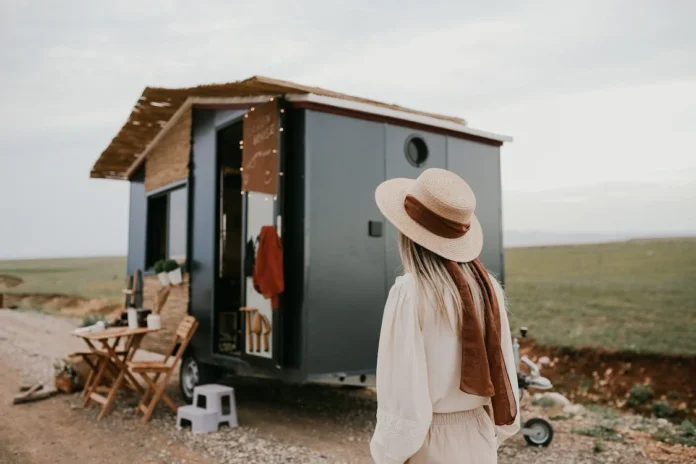Tiny home travel provides the ability to roam to new locations while still feeling at home. Whether you are looking for adventure, financial independence, or the simplicity of minimalism, traveling in a tiny home is a fun and eco-friendly means to experience the world. But like anything else, it also presents its own unique challenges and issues. In this guide, we will discuss all you need to know about traveling with a tiny home, from selecting the perfect model to handling legalities and having a hassle-free journey.
1. Selecting the Proper Tiny Home for Travel
All tiny homes are not made for frequent mobility. If you travel often, you need to choose a tiny home that suits your requirements. Consider the following factors:
Tiny House on Wheels (THOW) versus Stationary Tiny Home
A tiny house on wheels (THOW) is designed specifically for travel and is mounted on a trailer, so it is easier to move around. Stationary tiny homes, however, are intended for long-term siting and might not be ideal for traveling frequently.
Size and Weight Issues
Most states place limitations on trailer size. The majority of THOWs are below 13.5 feet tall, 8.5 feet wide, and 26 feet long to meet road regulations. Selecting a light-weight design assists in fuel efficiency and maneuverability.
Durability and Weather Resistance
Because your home will be subject to various weather conditions, it is important to choose materials that are hardy. Insulated walls, fortified roofing, and quality tires allow your home to keep up with changing climates.
2. Towing and Transportation
Towing a tiny home is not something to be taken lightly. Here’s what you should be considering before taking off:
Selecting the Right Vehicle
A heavy-duty truck or a strong towing vehicle is required to tow a tiny home. Make sure that your truck’s towing capacity is higher than the combined weight of your tiny home to avoid mechanical stress.
Knowledge of Road Laws
Various states and nations have unique road laws for oversized loads. Look for height, weight, and width limitations, along with required permits for crossing various areas.
Safety Inspections Before Leaving
Before moving your tiny home, inspect the tires, brakes, lights, and hitch connections. Secure all loose items inside to prevent shifting during travel. Having an emergency kit, including tire repair tools and a fire extinguisher, is also a good idea.
3. Finding Parking and Overnight Stops
One of the greatest challenges of traveling in a home is discovering where to park overnight or for an extended period. The following are some options:
Campgrounds and RV Parks
Numerous RV parks and campgrounds accommodate small homes on wheels. Check locations beforehand to ensure size limitations, hookups, and available facilities.
Boondocking (Off-Grid Camping)
For an even more off-the-grid experience, boondocking lets you camp in distant areas without the use of hookups. National forests, Bureau of Land Management (BLM) lands, and private property (with permission) are excellent choices.
Tiny Home-Friendly Communities
There are some communities made especially for tiny home travelers. They provide specifically designated spaces with water, electricity, and sewer hookups, and these communities are great for extended stays.
4. Managing Utilities and Sustainability
It takes planning to be comfortable in a small mobile home. This is how to remain comfortable and green:
Water and Wastewater Management
Make arrangements for installing a water tank or accessing available campgrounds’ hookups.
Employ a composting toilet to minimize wastage and avoid sewer hookups.
Make provisions for a greywater filtration system for ethical wastewater disposal.
Energy Sources
Solar panels generate renewable energy for off-grid travel.
Battery packs or portable generators can be backup power sources.
Propane cylinders can be used for heating and cooking purposes.
Internet and Connectivity
It’s important to remain connected on the road. Satellite internet, mobile hotspots, and campground Wi-Fi solutions assist you in maintaining contact and enjoying necessary online services.
5. Budgeting for Tiny Home Travel
Tiny home travel is less expensive than owning a home conventionally, yet it does cost. The important expenses are:
Fuel and maintenance for your tow vehicle.
Campground fees or land rent.
Insurance for your vehicle and tiny house.
Maintenance and repairs to your tiny house and appliances.
Budgeting and staying on top of expenses will allow you to enjoy financial independence without surprise billing.
6. Advantages and Disadvantages of Tiny Home Travel
Benefits:
Flexibility and Freedom: Go anywhere without being tied down to a specific location.
Minimalist Lifestyle: Keep clutter at a minimum and concentrate on experience over material possessions.
Cost-Effective Living: Save on traditional housing costs and property taxes.
Sustainability: Reduce your carbon footprint with energy-efficient living.
Challenges:
Legal Restrictions: Some areas have zoning laws that limit where tiny homes can park.
Weather Considerations: Harsh weather conditions may require extra insulation and preparation.
Maintenance Needs: Constant travel can lead to wear and tear on your tiny home and vehicle.
7. Tips for a Successful Tiny Home Journey
Plan Your Route: Plan roads, fuel stations, and overnight parking in advance.
Stay Organized: Utilize multi-purpose furniture and space-saving solutions to maximize storage space.
Join Tiny Home Communities: Share advice, support, and experiences with fellow travelers.
Practice Minimalism: Store only essentials to minimize weight and maximize mobility.
Regularly Inspect Your Home: Check for any damage, leaks, or maintenance required after every trip.
Conclusion
Traveling in a tiny home presents a great way to see the world while keeping a comfortable, eco-friendly lifestyle. With careful planning, trusty transportation, and efficient utility management, you can have the best of the open road without giving up on modern amenities. As a full-time wanderer or part-time traveler, the tiny home phenomenon allows you to live simply and effectively while experiencing adventure.




[…] Ultimate Guide to Tiny Home Travel […]